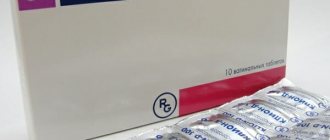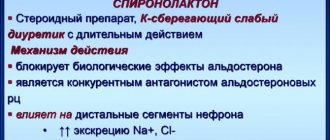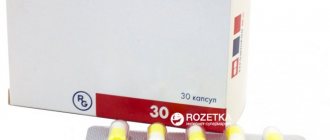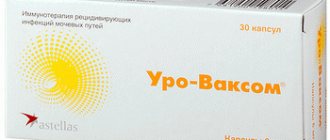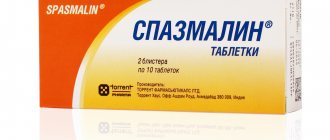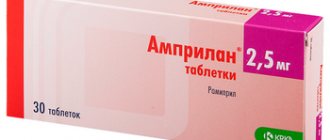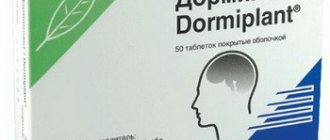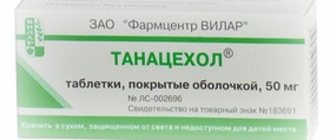24846
Verospilactone is one of the most effective drugs for edema. Its distinctive feature is that it does not wash out magnesium and potassium from the blood, thereby not disrupting the functioning of the cardiovascular and nervous systems.
Available in the form of flat tablets of white or cream color. Each of them has a chamfer and a risk. The tablets are packaged in plastic cells and a cardboard pack.
Release form and composition
- tablets: round, flat-cylindrical, with a score on one side and a bevel, white or white with a creamy tint, with a slight specific odor or almost odorless (10, 15, 20 and 30 pcs. in blister packs, in a cardboard pack of 1 , 2 or 3 packs);
- capsules: 25 mg – size No. 3, with a white body and cap; 50 mg – size No. 3, with a white body and a blue cap; 100 mg – size No. 1, with a blue body and cap; the contents of the capsules are white or white powder with a yellowish tint (10, 14, 15 and 20 pcs. in blister packs, 1, 2 or 3 packs in a cardboard pack).
Each pack also contains instructions for using Verospilactone.
Active substance – spironolactone:
- 1 tablet – 25 mg;
- 1 capsule – 25, 50 or 100 mg.
Excipients of tablets: lactose (milk sugar), colloidal silicon dioxide (Aerosil), potato starch, talc, magnesium stearate.
Additional capsule components: lactose monohydrate, magnesium stearate, povidone, potato starch, sodium lauryl sulfate, talc, colloidal silicon dioxide (Aerosil).
Capsule composition:
- 25 mg: body and cap – gelatin, titanium dioxide;
- 50 mg: body – gelatin, titanium dioxide; cap – gelatin, titanium dioxide, diamond black dye, patented blue dye;
- 100 mg: body and cap – gelatin, titanium dioxide, patented blue dye.
general information
In pharmacies, the drug is presented under the name Verospilactone, and its INN is Spironolactone, in accordance with the name of the active substance, due to which the therapeutic result is achieved. The drug is a potassium-sparing diuretic.
It is used for hypokalemia, high blood pressure and edema syndrome caused by kidney and heart diseases. Verospilactone helps remove excess fluid, which reduces the load on blood vessels and the heart. It also helps retain the necessary potassium in the body.
Release forms, cost
The product is produced in the form of tablets and capsules. They may contain 25, 50 and 100 mg of spironolactone. They are packaged in blisters of 10 pcs. The box may contain 1,2 or 3 blisters. The tablets are white and round in shape. They are flat, with a notch on one side. They have almost no smell. Capsules can be white or blue-white. Inside them there is a white powder with a yellowish tint.
The medicine is produced in Russia, so it is low in cost. It is sold only with a doctor's prescription. Medicine prices are presented in the table (Table 1).
Table 1 – Cost of Verospilakton
| Release form | Active substance content | Amount in a package | Price |
| Pills | 25 mg | 20 pcs. | 70-115 rub. |
| Capsules | 50 mg | 30 pcs. | 195-255 rub. |
| Capsules | 100 mg | 30 pcs. | 285-360 rub. |
Compound
The active component of the drug is spironolactone. In addition to it, additional components are included in tablets and capsules, thanks to which it is possible to give the medicine the appropriate form and ensure its long-term preservation. These components differ for each form of the drug (Table 2).
Table 2 - Composition of Veroshpilakton
| Pills | Capsules |
|
|
Pharmacodynamics and pharmacokinetics
The active component of the drug has a prolonged effect. It weakens the influence of aldosterone, so that water is not retained in the body. But at the same time, spironolactone prevents the active removal of potassium from the body. When it comes into contact with aldosterone, there is an increase in the excretion of sodium, water and chlorine ions in the urine, respectively, potassium and urea ions are excreted at a slower rate.
Blood pressure when using Verospilactone decreases due to the diuretic effect of the drug. This effect becomes noticeable a few days after the start of treatment. The product is most effective 7 hours after taking it. The duration of exposure lasts throughout the day.
Mechanism of action of spironolactone
Spironolactone is absorbed in the gastrointestinal tract, resulting in the formation of active metabolites. The maximum content of metabolites in the blood is recorded 2-4 hours after taking the tablets. The substances easily bind to plasma proteins. Spironolactone almost does not enter tissues and organs. But its metabolites may end up in breast milk or pass through the placental barrier.
During metabolic processes, this substance is converted into canrenone and a metabolite containing sulfur. Its elimination is two-phase. The main part of spironolactone and its metabolites is excreted from the body through the kidneys.
Pharmacological properties
Pharmacodynamics
The active ingredient of Verospilactone is spironolactone - a potassium-sparing diuretic, a specific antagonist of aldosterone (mineralocorticosteroid hormone of the adrenal cortex) of prolonged action.
The mechanism of action of the drug is due to its ability to retain sodium aldosterone and water in the distal parts of the nephron, suppress the potassium-removing effect of mineralocorticosteroid hormone, and reduce the synthesis of permeases in the aldosterone-dependent area of the collecting ducts and distal tubules.
Spironolactone binds to aldosterone receptors, as a result of which it increases the excretion of sodium, chlorine and water ions in the urine, reduces the acidity of urine, and reduces the excretion of urea and potassium ions.
The effect of the drug reaches its maximum 7 hours after taking Verospilactone and lasts for at least 24 hours.
The hypotensive effect of spironolactone is explained by the presence of a diuretic effect, which is not constant: it develops on days 2–5 of treatment.
Pharmacokinetics
Once in the gastrointestinal tract, spironolactone is quickly and completely absorbed.
Approximately 98% bound to plasma proteins (canrenone metabolite – 90%). The maximum plasma concentration (Cmax) of canrenone is achieved within 2–4 hours after taking Verospilactone.
The volume of distribution is 0.05 l/kg.
When taking Verospilactone regularly for 15 days at a dose of 100 mg, Cmax is 80 ng/ml. After the next morning dose, the time to reach Cmax is 2–6 hours.
The drug penetrates poorly into tissues and organs, but spironolactone itself and its metabolites penetrate the placental barrier, and canrenone penetrates into breast milk.
The drug is metabolized to form active metabolites: predominantly (80%) - a metabolite containing sulfur, to a lesser extent (20%) - canrenone.
Verospilactone is excreted from the body mainly by the kidneys (50% in the form of metabolites, 10% unchanged) and partially through the intestines. T1/2 (half-life) of spironolactone - 13-24 hours, active metabolites - up to 15 hours. Canrenone is excreted mainly by the kidneys in two phases: T1/2 of the first phase - 2-3 hours, T1/2 of the second phase - 12-96 hours .
In patients with heart failure and cirrhosis, the duration of T1/2 increases. However, there are no signs of accumulation of Verospilactone. The likelihood of drug accumulation in the body increases in the presence of concomitant hyperkalemia and chronic renal failure.
Verospilactone
Active substance:
Spironolactone*
Pharmgroup:
Diuretics
Average price in pharmacies
| Name | Manufacturer | average price |
| Verospilactone 0.025 n20 tablet | OBOLENSKOYE | 58.00 |
| Verospilactone 0.05 n30 caps | OBOLENSKOYE | 176.00 |
| Verospilactone 0.1 n30 caps | OBOLENSKOYE | 256.00 |
Analogs for the active substance:Aldactone Vero-Spironolactone Veroshpiron Spirix Spironaxane Spironol Spironolactone Spironolactone (Unilan) Urakton |
Indications for use
- edema syndrome in chronic heart failure (as a single drug or in combination with standard therapy);
- essential hypertension (as part of combination therapy);
- hypokalemia and/or hypomagnesemia (as part of complex therapy for their prevention during the use of diuretics and if it is impossible to prescribe other methods of correcting potassium levels);
- conditions in which secondary hyperaldosteronism is possible, including nephrotic syndrome, liver cirrhosis with edema and/or ascites and other conditions accompanied by edema;
- primary hyperaldosteronism (Conn's syndrome) - for a short preoperative course of therapy.
Verospilactone is also used as a diagnostic tool to establish primary hyperaldosteronism.
Contraindications
- hyponatremia;
- hyperkalemia;
- anuria;
- severe renal failure (creatinine clearance less than 10 ml/minute);
- diabetes mellitus with confirmed renal failure;
- Addison's disease;
- lactose intolerance, lactase deficiency, glucose-galactose malabsorption syndrome;
- children under 3 years of age;
- During pregnancy and breastfeeding;
- simultaneous use of potassium supplements, eplerenone or other potassium-sparing diuretics;
- hypersensitivity to any component of Verospilactone.
Carefully:
- diabetic nephropathy;
- metabolic acidosis;
- hypercalcemia;
- liver failure;
- cirrhosis of the liver;
- atrioventricular (AV) block;
- anesthesia (general or local);
- diabetes mellitus with suspected or confirmed chronic renal failure;
- surgical interventions;
- enlargement of the mammary glands;
- menstrual irregularities;
- taking medications that cause gynecomastia;
- elderly age.
Verospilactone, instructions for use: method and dosage
Verospilactone capsules and tablets should be taken orally.
Recommended dosage regimens for adults:
- edema syndrome in chronic heart failure (in combination with thiazide or loop diuretics): daily dose – 100–200 mg in 2–3 doses for 5 days. Depending on the effect, the daily dose may be reduced to 25 mg. The doctor selects the maintenance dose individually. The highest permissible dose is 200 mg per day;
- essential hypertension (as part of combination therapy): 50–100 mg 1 time per day, if necessary, the dose is gradually (once every 2 weeks) increased to 200 mg. It takes at least 2 weeks to achieve an adequate response to therapy. Depending on the effect and tolerability of Verospilactone, the dose is adjusted;
- hypokalemia and/or hypomagnesemia: daily dose – 25–100 mg in one or more divided doses. If oral potassium supplements and other methods of replenishing it are ineffective, the daily dose may be increased to 400 mg;
- edema in liver cirrhosis: if the ratio of sodium and potassium ions in the urine exceeds 1, the daily dose is usually 100 mg; if the ratio is less than 1, the daily dose is 200–400 mg. The doctor selects the optimal maintenance dose individually;
- edema in nephrotic syndrome: in a daily dose of 100–200 mg (if other types of therapy are ineffective);
- severe hyperaldosteronism and hypokalemia: daily dose – 300–400 mg in 2–3 doses, after improvement of the condition, the dose is gradually reduced to 25 mg per day;
- idiopathic hyperaldosteronism: 100–400 mg per day.
Diagnosis and treatment of primary hyperaldosteronism:
- short diagnostic test: daily dose – 400 mg in several doses for 4 days. If the concentration of potassium in the blood increases while taking Verospilactone and decreases after its withdrawal, there is reason to assume that the patient has primary hyperaldosteronism;
- long-term diagnostic test: daily dose – 400 mg in several doses over 3-4 weeks. If, with the help of Verospilactone, it is possible to correct arterial hypertension and hypokalemia, it can be assumed that the patient has primary hyperaldosteronism.
After any of the above tests, primary hyperaldosteronism is established using more accurate diagnostic methods. As a short preoperative course, Verospilactone is prescribed in a daily dose of 100–400 mg in 1–4 doses throughout the entire preparatory period. If surgery is not indicated, Verospilactone is used for long-term maintenance therapy, prescribed in the minimum effective dose, which the doctor selects individually depending on the clinical situation.
For children over 3 years old with edema in the first 5 days, Verospilactone is prescribed in a daily dose of 1–3.3 mg/kg or 30–90 mg/m2 in 1–4 doses, after which the dose is adjusted. If necessary, it is possible to increase the daily dose by 3 times compared to the original.
Analogs
The use of analogue drugs is practiced when it is not possible to use the drug in question.
Structural
Geeriki are used if Veroshpilactone is not available for sale. They differ in the same composition and the same action. These include:
Veroshpiron. Its main component is spironolactone. The product is sold in the form of tablets and capsules. Veroshpiron is intended for the treatment of hypertension, combating edema and eliminating hypokalemia. Its cost may vary depending on the number of medicinal units in the package and the content of the active ingredient. It amounts to 70-300 rubles.- Spironolactone. Its basis is a substance with the same name. The drug belongs to the group of diuretics, helps lower blood pressure, and helps retain potassium in the body. Available in tablets containing 25 or 100 mg of active ingredient. Spironolactone costs 30-100 rubles.
- Vero-Spironolactone. The drug is used for nephrotic syndrome, high blood pressure, and Conn's syndrome. Its main ingredient is spironolactone. It goes on sale in tablets containing 25 mg of the active substance. Its cost is 50-200 rubles.
These medications are very similar to Verospilactone, and you need to take them almost the same way. But it is better to first consult with a specialist.
Drugs with similar effects
They differ from Verospilactone in composition, but have similar properties. They are used if there are contraindications to the use of this product. Among them are:
- Espiro. The active ingredient of the drug is eplerenone. Release form: tablets containing 25 and 50 mg of this component. The drug is a potassium-sparing diuretic. It is used for heart diseases. Its use is prohibited in persons under age, with liver failure, intolerance to the composition, etc. Espiro is sold at a price of 550 to 1200 rubles.
Decrease. It is a potassium-sparing diuretic based on eplerenone. There are tablets with this name on sale. They are used for high blood pressure, heart disease, and hypokalemia. You will have to refuse to use them if you are individually sensitive to the composition, or have severe renal or liver failure. For a package of tablets you will have to pay from 600 to 1300 rubles.- Eridanus. The active ingredient of the drug is eplerenone. The product is intended to reduce blood pressure and eliminate edema; it belongs to the group of diuretics. Not suitable for the treatment of children, requires caution in the elderly. Sold with a doctor's prescription at a cost of 570 to 1100 rubles.
- Indapamide. Its active component is a substance with the same name. It is produced in tablets and capsules. Indapamide is intended to reduce blood pressure. You should not use it if you have diabetes, pregnancy, or individual sensitivity to the composition. The medicine is sold at prices ranging from 30 to 170 rubles.
Hypothiazide. The basis of the tablets is hydrochlorothiazide. Each of them contains 25 or 100 mg. It is a diuretic and helps lower blood pressure. It is forbidden to take Hypothiazide if you have diabetes, anuria, renal or liver failure. On average, this drug costs up to 200 rubles.
A doctor should choose a medicine from among those listed, since only he can evaluate the clinical picture and make sure there are no contraindications.
Side effects
- from the central nervous system: drowsiness, confusion, dizziness, lethargy, headache, ataxia, muscle spasm;
- from the musculoskeletal and connective tissue: osteomalacia, cramps of the calf muscles;
- from the kidneys and urinary tract: acute renal failure;
- from the respiratory system: shortness of breath;
- from the liver: impaired liver function;
- from the gastrointestinal tract: intestinal colic, constipation, gastritis, diarrhea, nausea, abdominal pain, vomiting, ulceration and bleeding from the gastrointestinal tract;
- from the endocrine system: deepening of the voice, in women - amenorrhea, dysmenorrhea, metrorrhagia during menopause, pain in the mammary glands, hirsutism, menstrual irregularities, breast carcinoma; in men - decreased potency and erection, gynecomastia (the risk of development depends on the dose, duration of treatment, is usually reversible and disappears after discontinuation of Verospilactone, in some cases the mammary gland remains slightly enlarged);
- from the blood and lymphatic system: thrombocytopenia, agranulocytosis, megaloblastosis;
- from the skin and subcutaneous tissues: hypertrichosis, alopecia;
- allergic reactions: drug fever, maculopapular and erythematous rash, eosinophilia, pruritus, urticaria, toxic epidermal necrolysis, Steven-Johnson syndrome;
- from laboratory parameters: disturbance of water and electrolyte balance (hyponatremia, hyperkalemia), increased urea concentration, hypercreatininemia, hyperuricemia, disturbance of the acid-base state (alkalosis, metabolic hyperchloremic acidosis).
Veroshpilakton (Veroshpiron) capsules 50 mg No. 30
A country
Russia
The country of production may vary depending on the batch of goods. Please check with the operator for detailed information when confirming your order.
Active substance
Spironolactone
Compound
Active substance: Spironolactone.
pharmachologic effect
It has a diuretic, potassium-sparing, hypotensive effect. Inhibits the reabsorption of sodium ions through the apical membrane of renal epithelial cells and increases the excretion of sodium, chlorine and water ions in the urine. It has a potassium-sparing effect: it inhibits the aldosterone-regulated exchange of sodium ions for potassium ions, reduces the secretion and excretion of potassium, magnesium, urea and increases their concentration in the blood. Increases excretion. Reduces urine acidity. The diuretic effect appears on the 2-5th day and persists for 2-3 days after stopping use. Antihypertensive activity is due to an increase in the excretion of sodium ions and a decrease in the volume of circulating blood and extracellular fluid; appears in the 2-3rd week of treatment. Increases the activity of glucuronyl transferase, increases the amount of conjugated bilirubin in the urine, reduces the risk of arrhythmias. When taken orally, it is completely absorbed. It is quickly and intensively biotransformed in the liver with the formation of several active metabolites. Almost completely binds to blood plasma proteins. Excreted in urine, partially excreted in bile and feces.
Indications for use
Primary hyperaldosteronism, aldosterone-producing adrenal adenoma, edema syndrome against the background of secondary hyperaldosteronism in chronic heart failure, liver cirrhosis (with ascites or edema), nephrotic syndrome; arterial hypertension due to secondary hyperaldosteronism, some forms of essential; hypokalemia, incl. during therapy with saluretics and digitalis preparations, edema and nephropathy in pregnant women, edematous syndrome in newborns, infectious-allergic bronchial asthma (especially complicated by right heart failure), myopathy, myasthenia gravis, parkinsonism, polycystic ovary syndrome (prevention and treatment), hirsutism (treatment), premenstrual syndrome, premature puberty in young men, bronchopulmonary dysplasia.
Interaction
Steroidal anti-inflammatory drugs and diuretics (benzothiadiazine derivatives, furosemide, ethacrynic acid, etc.) enhance and accelerate the diuretic and natriuretic effects, ACE inhibitors (because they inhibit the release of aldosterone), indomethacin, cyclosporine, other potassium-sparing diuretics, potassium preparations (in including potassium chloride) and potassium supplements - increase the risk of developing hyperkalemia (especially against the background of renal failure). Sympathomimetic drugs reduce antihypertensive properties, NSAIDs (indomethacin and acetylsalicylic acid) - diuretic, natriuretic and antihypertensive activity and increase the risk of developing renal failure. Potentiates the effect of diuretic and antihypertensive drugs, enhances the toxic effects of lithium preparations, prevents the development of hypokalemia when prescribing furosemide and other diuretics that cause it, reduces the effect of cardiac glycosides, anticoagulants (coumarin derivatives, indandione, heparin), the vasoconstrictor effect of adrenaline and inhibits the antiulcer agent - carbenoxolone (accelerates biotransformation and excretion).
Side effect
Hyperkalemia, hyponatremia, increased blood concentrations of urea, creatinine, uric acid, disturbances of water-salt metabolism and acid-base balance (metabolic hyperchloremic acidosis or alkalosis); nausea, vomiting, dyspeptic symptoms, abdominal pain, intestinal motility disorders, diarrhea or constipation, intestinal colic, gastritis, ulceration and bleeding in the gastrointestinal tract; headache, dizziness, ataxia, drowsiness, mental disorders; muscle spasms; gynecomastia, erectile dysfunction, virilization in women (deepening of the voice, hirsutism and other androgenic effects), menstrual disorders, incl. dysmenorrhea, amenorrhea, metrorrhagia during menopause, etc., breast tenderness, breast carcinoma; megaloblastosis, agranulocytosis, thrombocytopenia, photosensitivity; allergic reactions - maculo-, papulo-, and erythematous rashes, urticaria, drug fever, itching, etc.
Contraindications
Hypersensitivity, hyperkalemia, azotemia, anuria, renal failure (acute, chronic, with significant damage to excretory function, including chronic nephritis in the nephrotic stage).
Overdose
Symptoms: nausea, vomiting, diarrhea; severe hyperkalemia (paresthesia, muscle weakness, arrhythmias), hyponatremia (dry mouth, thirst, drowsiness, etc.); hypercalcemia, increased urea levels in the blood. Treatment: maintaining vital functions, immediate removal of stomach contents; in case of hyperkalemia - rapid intravenous administration of a 20-50% glucose solution and insulin - 0.25-0.5 U/g glucose (repeat if necessary).
special instructions
Restrictions on use: Liver dysfunction, diabetes mellitus (especially diabetic nephropathy), predisposition to metabolic acidosis, hyponatremia, hypercalcemia, menstrual irregularities accompanied by enlarged mammary glands, the first 3 weeks of pregnancy, breastfeeding. Prescribed with caution in case of incomplete atrioventricular block, decompensated cirrhosis of the liver, surgical intervention, against the background of drugs that cause gynecomastia, local and general anesthetics, the elderly. When combined with cardiac glycosides, diuretics and antihypertensive drugs, doses should be reduced. During therapy, it is necessary to carefully monitor the content of electrolytes, the level of nitrogen, urea and creatinine in the blood, blood pressure, and avoid introducing excess amounts of potassium into the body.
Dispensing conditions in pharmacies
On prescription
Overdose
In case of an overdose of Verospilactone, the following symptoms are possible: diarrhea, nausea, vomiting, increased urea concentration, dehydration, hypercalcemia, hyponatremia (drowsiness, dry mouth, thirst), hyperkalemia (muscle weakness, paresthesia, arrhythmias), skin rash, dizziness.
After taking a dose significantly higher than the recommended one, it is advisable to perform gastric lavage. Treatment of arterial hypotension and dehydration is symptomatic. In case of hyperkalemia, restoration of water-electrolyte balance is indicated through the use of potassium-removing diuretics and rapid administration of a 5-20% glucose/dextrose solution with insulin (0.25-0.5 IU of insulin per 1 g of glucose/dextrose), if necessary, the administration is repeated. In severe conditions, hemodialysis is performed.
Storage and overdose
If the medicine is taken strictly as prescribed and the recommended dose is not exceeded, the drug is well tolerated. But if an overdose was allowed, in this case the patient may experience nausea and vomiting, dizziness, arrhythmia and muscle weakness.
It is also possible to develop drowsiness and apathy, and dehydration may begin. In this case, immediate consultation with a doctor is required. The patient is given gastric lavage and symptomatic treatment is prescribed. The patient's condition is constantly monitored in the hospital.
The drug is released strictly according to a doctor's prescription. The cost in Moscow pharmacies for Veroshpilakton is 67 rubles. Depending on the dosage and manufacturer, the price may be slightly higher.
The product has a lot of analogues with the same composition, but with a smaller amount of the active ingredient. Most often, the pharmacy can offer:
- Veroshpiron.
- Aldactone.
- Spirix.
- Spironol.
If you know what the difference is between Veroshpiron, Veroshpilactone or another drug, you can choose an analogue. But the best option would be to consult a doctor for a replacement medication if there are contraindications to taking Verospilactone. But basically, analogues may differ in some components, so you need to carefully study the instructions for use.
special instructions
Elderly people and patients with impaired liver and kidney function require monitoring of renal function and serum electrolytes. The same applies to cases when non-steroidal anti-inflammatory drugs are used simultaneously.
Verospilactone makes it difficult to determine adrenaline, cortisol and digoxin in the blood.
During treatment, it is prohibited to drink alcoholic beverages; it is recommended to exclude potassium-rich foods from the diet.
Impact on the ability to drive vehicles and complex mechanisms
Caution should be exercised in activities that require quick reactions and high concentration, including driving vehicles and working with complex machinery.
Drug interactions
- diuretics (ethacrynic acid, furosemide, thiazides and thiazide-like), glucocorticosteroids: the diuretic and natriuretic effects of spironolactone are enhanced and accelerated;
- carbenoxolone: promotes sodium retention by spironolactone;
- indomethacin, salicylates: the diuretic effect of spironolactone is reduced;
- lithium: its clearance decreases, toxic effect increases;
- carbenoxolone: accelerates its metabolism and excretion;
- cardiac glycosides: their toxicity decreases;
- diuretics and antihypertensive drugs: their effect is enhanced;
- non-steroidal anti-inflammatory drugs: the diuretic and natriuretic effects of spironolactone decrease, the likelihood of developing hyperkalemia increases;
- narcotic substances, barbiturates, ethanol: orthostatic hypotension increases;
- non-depolarizing muscle relaxants (for example, tubocurarine): their effect may be enhanced;
- digoxin: its half-life increases, the likelihood of digoxin intoxication increases;
- mitotane: its effect decreases;
- cholestyramine, ammonium chloride: the risk of developing hyperkalemic metabolic acidosis increases;
- indomethacin, cyclosporine, aldosterone blockers, angiotensin II receptor antagonists, angiotensin-converting enzyme inhibitors, potassium supplements, potassium-sparing diuretics, potassium supplements: the likelihood of developing hyperkalemia increases;
- phenazone (antipyrine): its metabolism increases;
- indirect anticoagulants (heparin, indanedione, coumarin derivatives): their effectiveness decreases;
- buserelin, triptorelin, gonadorelin: their effectiveness increases;
- fludrocortisone: a paradoxical increase in tubular secretion of potassium occurs.
Verospilactone reduces the sensitivity of blood vessels to norepinephrine, so care should be taken when performing anesthesia.
Compatibility with other drugs
The difference between Veroshpilactone and Veroshpiron is that the first drug helps reduce the possibility of glycoside poisoning and the therapeutic effect of indirect anticoagulants. If you use lithium and Verospilactone at the same time, the effect of the first means increases. Under the influence of Verospilactone, susceptibility to norepinephrine is significantly reduced. The main component of the drug increases the half-life of digoxin.
When used simultaneously with glucocorticosteroids and other diuretics, the effect of the latter is enhanced. And when used together with NSAIDs, the diuretic effect is significantly reduced. The healing effect of antihypertensive drugs is enhanced several times.
If Verospilactone is taken simultaneously with potassium supplements or potassium-sparing diuretics, there is a possibility of hypercalcemia. Using indomethacin and salicylates with this drug may result in water retention in the body and a decrease in the diuretic functions of the drug. When the drug is used simultaneously with medications containing ammonium chloride, hyperkalemic metabolic acidosis may develop.
Verospilactone significantly reduces the effect of drugs containing methothane. But it increases the effect of buserelin, gonadorelin and triptorelin on the body.
